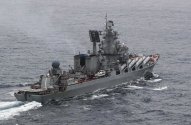In my opinion
There are many other critical factors determining a ship’s relative survivability in case of battle damage than bigger ships mean more hit points.
The truth is the last time when the russian navy had serious experience with dealing with major warship damage during battle was during the russo-japanese war 117 years ago. In that war much of the experience sank and didn’t make it back to russia. Russia’s naval experience during WWII is trivial compared to those of the major naval powers and did not show their competence in any good light. During the cold war the soviets built a very large surface fleet but on average they spent only about 20% as much time at sea as their american counterpart, the rest of the time their men stayed in barracks on land while their NATO counterparts were still operating the ships at sea in rough weather, firing weapons and gaining experience with how each part of their ship behaves in routine operation abs during accidents abs incidents. It is easy to imagine lack of experience caused them to over look small seemingly trivial aspect of how to design equip and operate warships that only experience can show to be potentially critical, making their ships more susceptible to losses due to damage control flaws and oversights then their western counterparts.
theoretically, yes. but a lot of other factors play a big, in many cases bigger, role too. the location of the hits, the number and density of watertight partitions, whether the ship has any internal protective plating to limit splinter penetration, is the location of pumps and fire main risers well thought out. Is the ship well set up to establish damage control boundaries to contain fire and flooding, is the crew well trained, was the ship at action station with compartments well closed down. is the ship painted with sufficiently fire proof paint, Are there extraneous flammable substances in the ships is the internal furniture, equipment, insulation etc chosen to avoid putting out toxic or opaque smoke during fires, etc etc.Well theoretically bigger ship has more water tight compartments, so given the same damage delivered by say 200kg warhead bigger ship has a larger proportion of buoyancy intact compared to smaller ship.
Problem is given the decrepit state of repair, how many of Moskva's water tight compartments can be considered truly water tight? Zi Ya Zhou's video mentioned they saw bulkhead doors held together with ropes in her sister ship doesn't inspire much confidence....
Also Russia's school of thought of warship design AKA "Stuff as many weapons as humanly possible onto a hull" is not helping..... If a AShM is to hit the ship it would struggle to find a spot where there isn't some boom boom's waiting to cook off....
There are many other critical factors determining a ship’s relative survivability in case of battle damage than bigger ships mean more hit points.
The truth is the last time when the russian navy had serious experience with dealing with major warship damage during battle was during the russo-japanese war 117 years ago. In that war much of the experience sank and didn’t make it back to russia. Russia’s naval experience during WWII is trivial compared to those of the major naval powers and did not show their competence in any good light. During the cold war the soviets built a very large surface fleet but on average they spent only about 20% as much time at sea as their american counterpart, the rest of the time their men stayed in barracks on land while their NATO counterparts were still operating the ships at sea in rough weather, firing weapons and gaining experience with how each part of their ship behaves in routine operation abs during accidents abs incidents. It is easy to imagine lack of experience caused them to over look small seemingly trivial aspect of how to design equip and operate warships that only experience can show to be potentially critical, making their ships more susceptible to losses due to damage control flaws and oversights then their western counterparts.
Last edited:

